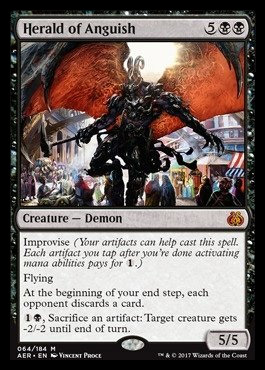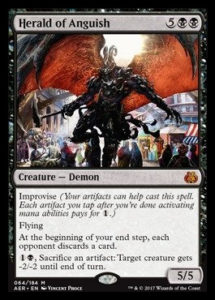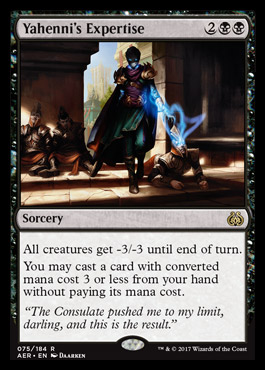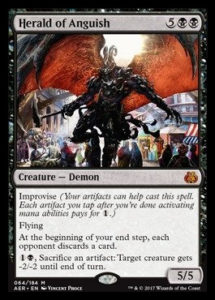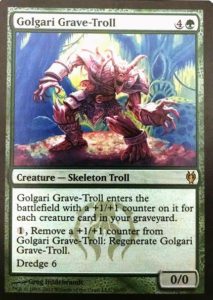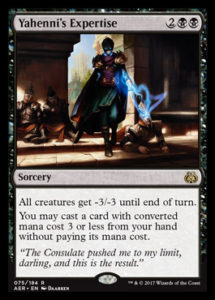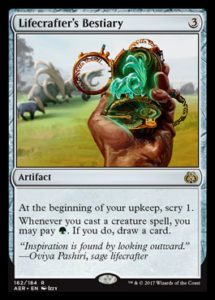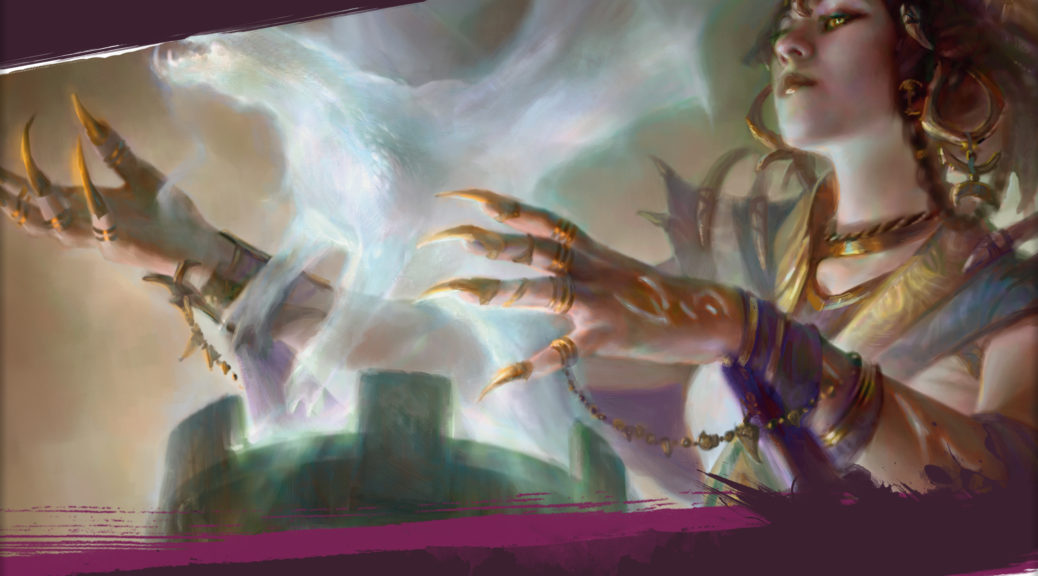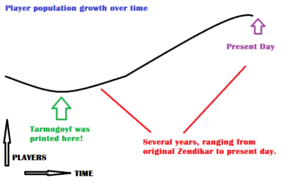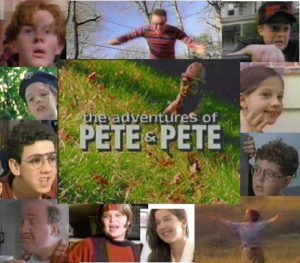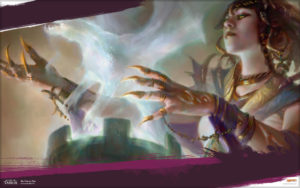With the Lord of the Rings: Tales of Middle Earth Magic the Gathering set now fully revealed it’s safe to say that Commander fans have plenty to be excited about. From fantastic new commanders to excellent new staples in multiple colors, the LOTR experiment seems set to be a great success even without the intense hunt for the 1/1 The One Ring.
Alongside the main set release, WoTC has also tabled the usual slate of four new pre-constructed Commander decks. In looking over the deck lists, one of the decks in particular jumped out at me as being particularly synergistic and primed for easy upgrades. Take a gander at the Food & Fellowship deck over here. And here is my upgraded version: The Hobbit’s Banquet.
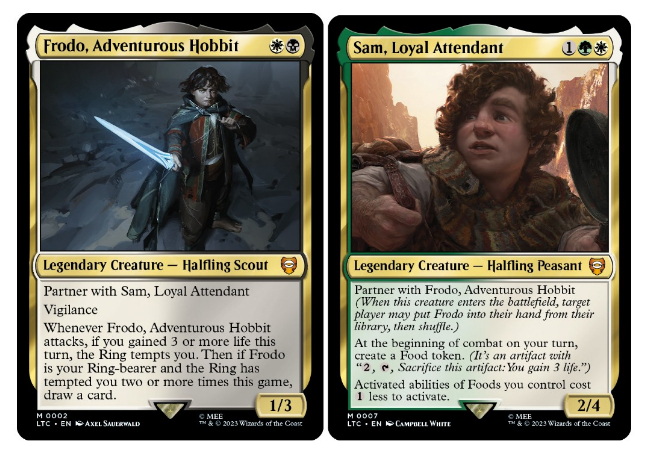
It should come as no shock that Wizards wants their Frodo and Sam deck to be popular, but given that Food has been one of the more underwhelming tokens in Commander play to date, the freshly acquired power level of this strategy based on all the new cards may catch many players off guard.
The first key pillar of strength in this list is your access to dual commanders. The partner ability has already proven to be highly effective in strategies like Tymna and Thrasios, and the synergy between Frodo and Sam is much more specific. Frodo’s role here is to leverage consistent life gain from food tokens and other sources of life gain to ensure that you can achieve all four levels of the ring tempting you by the mid-game, and in doing so, generate a ton of card advantage. Let’s review what the temptations the ring has to offer, shall we?
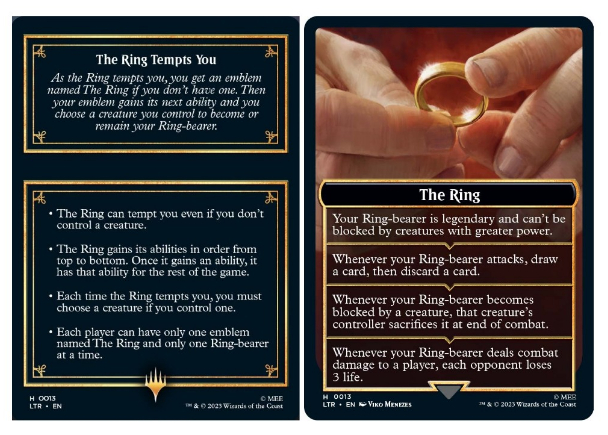
So along the way we get to keep choosing a new ring bearer, and eventually our ring bearer is legendary, can’t be blocked by creatures with greater power, loots on attack, forces blockers to be sacrificed at end of combat and hits all opponents for 3 if it hits a player. That’s a pretty good stack of bonuses, especially when the emblem can’t be interacted with and the bonuses last all game once you have them. Sure, they can keep killing your ring bearer, but the reality is that in this deck, they are going to have other threats to worry about that don’t care about attacking. This means Frodo will often get to do his job pretty well at least into the mid-game, where your combo kill plan can take over.
As the other half of your dynamic Commander duo, Sam is an excellent engine for any food deck. He guarantees food production every turn, and makes all food cheaper to activate by 50%! That’s a very important set of abilities for this deck, so generally speaking you will want to spend more resources protecting Sam than Frodo.
Food Engine Supporting Cast
While Sam and Frodo form the core of your synergy, their friends greatly expand your combo potential and all work together as a finely tuned value engine building towards draining or bleeding out the table.
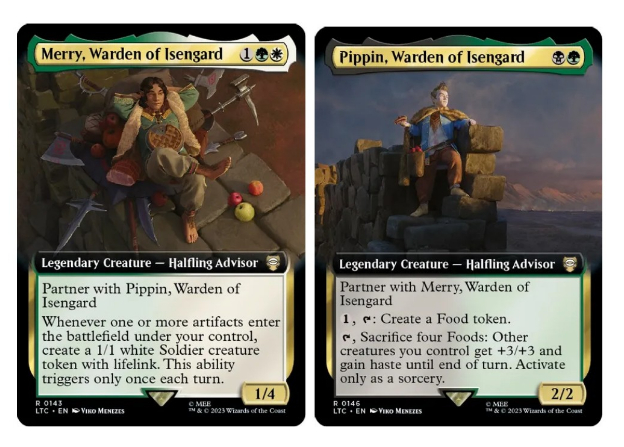
Merry, Warden of Isengard and Pippin, Warden of Isengard provide excellent food synergy in this deck, and also help further your theme of constant access to key creatures via their partner ability enabling you to pull the missing warden out of your deck when you cast the other. Merry rewards artifact production with 1/1 lifelink tokens, which all of your token doublers interact with and the lifelink on those tokens assists with your life gain synergies. Pippen makes food tokens for one mana while also providing an overrun effect for the mid to late game once you have a pile of food. Both cards being halflings means they are also solid ring bearers and can make good use of Bilbo’s Ring.
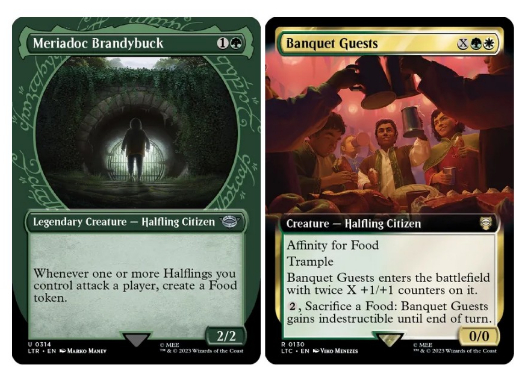
Meriadoc Brandybuck provides backup for Sam’s food during the attack phase strategy. Banquet Guests cast into a board with four food tokens would cost WG for an 8/8 that can sac food to gain indestructible until end of turn, marking it as a sneaky Hogaak variant in this build. Frodo Baggins ramps up your incidence of ring temptations and provides an additional ring bearer option.
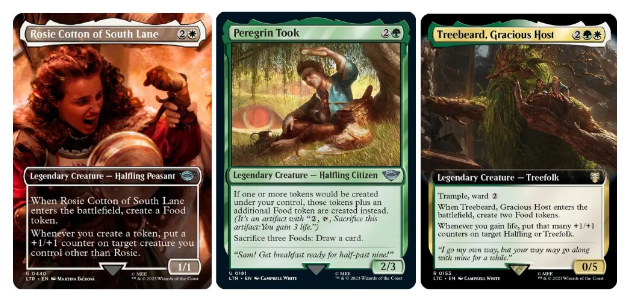
Rosie Cotton of South Lane makes one or more food tokens and rewards further token production of any kind with +1/+1 counters on any creature other than herself. This was very good in games where she showed up. Peregrin Took both doubles food production AND lets you trade food for cards. Excellent! Treebeard, Gracious Host was a monster in the games we played last night, adding two or more food to the table while immediately providing the threat of growing itself or a ring bearer to massive size in short order.
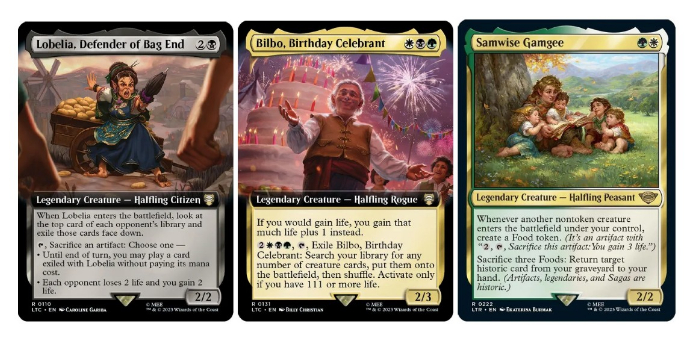
Lobelia, Defender of Bag End lets you sac your array of artifacts to either cast free spells or drain the table. Bilbo, Birthday Celebrant ramps up the life gain, and provides a ridiculous end game should said gain get out of control. Samwise Gamgee helps crank out food and then turn that into additional redundancy if you need to retrieve one of your many historic cards from the yard.
Token Doublers
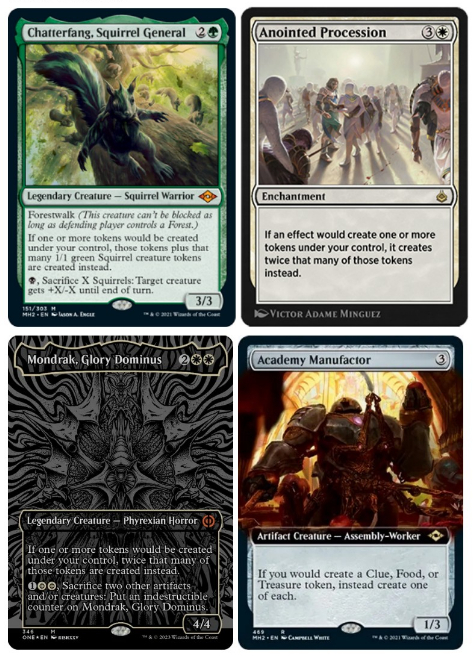
Cards that can double (or quadruple or more!) your token output are fantastic in this deck. Not only are they ratcheting up your food production, but they also have a shot at multiplying incidental creature tokens in the build from cards like Farmer Cotton, as well as clues and treasure from Academy Manufactor or Smothering Tithe. As such, you will definitely want all of Parallel Lives, Anointed Procession, Mondrak Glory Dominus and possibly a Doubling Season in a flex slot. These cards all interact, to additionally multiply token production from 2x to 4x and beyond, so critical mass is a good way to end the game in combination with your drain effects. Chatterfang, Squirrel General is a natural fit here from multiple angles, providing a forest walking ring bearer, a ton of squirrel tokens to double and some creature control on an adorable body.
Win Conditions
This deck doesn’t need to win in combat at all, allowing you to ignore a lot of what your opponents are up to in your average game and just focus on establishing and protecting your engine. Your primary route to victory will typically consist of overwhelming artifact token production leading to mass artifact sac to drain the table.
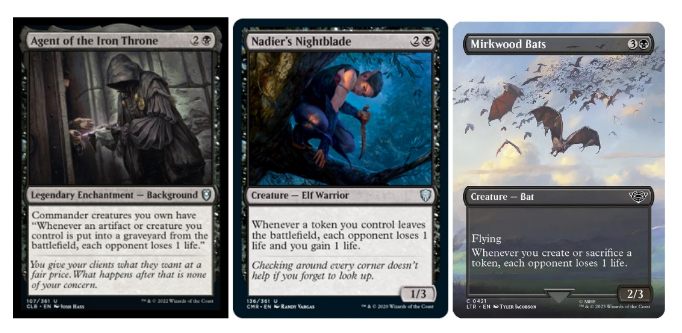
Agent of the Iron Throne (CLB) can’t be used as a background in the command zone here but it is still excellent in the 99 given that you have two commanders and are likely to have one in play to bleed the table whenever you sac artifacts. Nadier’s Nightblade (CMR) is even better, as it loses the requirement for a commander to be present, and drains rather than bleeds. And of course Mirkwood Bats is the nastiest of all, bleeding each opponent on both your token creation AND sacrifice.
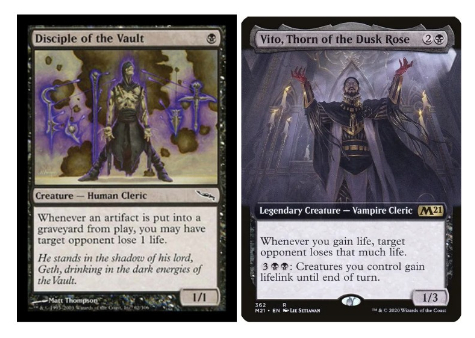
Disciple of the Vault can only bleed one opponent at a time, but it does so whenever anyone sacs a treasure so it seriously punishes a treasure heavy pod for just one black mana.Vito, Thorn of the Dusk Rose and Sanguine Bond punish a single opponent for your constant life gain. Add in Exquisite Blood to complete the two card combo if you’re into that sort of thing. Bloodchief Ascension furthers your table drain shenanigans.
I prefer Protection Racket in my drain focused decks, but you may decide to find room for Black Market Connections as an alternative. Finally, Felidar Sovereign presents a must kill threat, lest you win the game on the following turn. Aetherflux Reservoir can fill a similar role. I haven’t included Bolas’s Citadel here, but that’s also an option.
Protection Spells
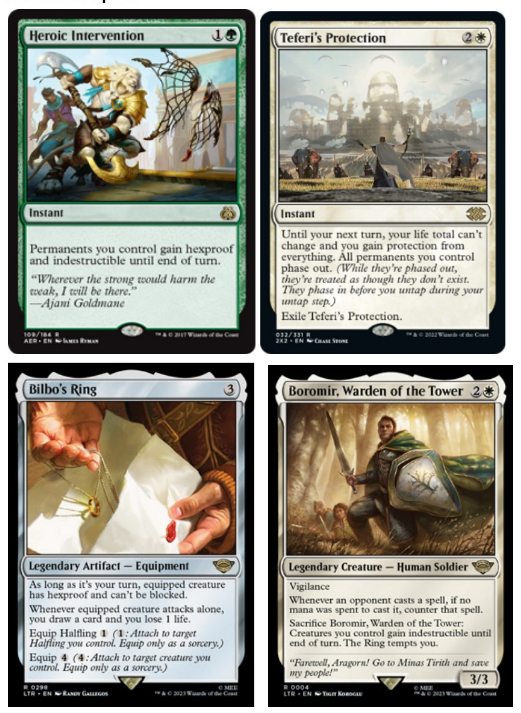
As with most low slung creature combo decks, you are particularly vulnerable to sweepers and given that your action relies heavily on both creatures and artifacts, you aren’t going to be looking to run many sweepers of your own. Instead, you will likely want some efficient point removal, defensive enchantments and a quiver of instant speed protection spells to protect your creature combo engines.
Heroic Intervention, Teferi’s Protection, Akroma’s Will and Clever Concealment provide an excellent core protection package. Given your access to dual commanders, find room for Flawless Maneuver if you like instead of my chosen Shalai, Voice of Plenty. Serra Paragon recovers most of what you might care about ending up in your graveyard.
The One Ring provides a turn cycle of respite from most threats with trailing card draw balanced against life loss you can easily stomach given all of your food tokens. Bilbo’s Ring does excellent work in this deck full of hobbits and ring tempting, making sure your ring bearer is unblockable and hexproof on your turn and drawing a card per attack cycle in a deck that could care less about the single life loss. When the ring is on Frodo, you get to draw up to 3 cards per attack via the combination of rings and abilities.
Flowering of the White Tree puts a tax on targeting your various legendary ring bearers and combo pieces, while simultaneously turning them into bigger threats and doubling your creature token size. Boromir, Warden of the Tower is a fresh white EDH staple that does double duty here, protecting your team and shutting down cascade shenanigans, pitch spells and any other free spells your opponents are trying to leverage. Samwise the Stouthearted provides additional protection for your key engine pieces while adding a ring temptation trigger.
Removal
I’ve chosen to go light on removal here, but season to taste. For now I’m running just Path to Exile, Swords to Plowshares, and Claim the Precious to deal with key threats. Voracious Fell Beast provides a solid ring bearer that can kill three creatures and make three food tokens. Beyond that you’re looking to race to the end game by draining the table so get your your spices and get cooking.
Life Gain Doublers
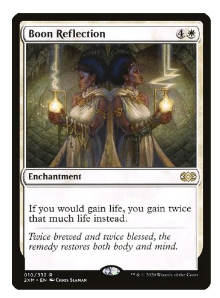
Boon of Reflection neatly doubles all your life gain. So does Rhox Faithmender and both cards are auto includes here.
Utility Cards
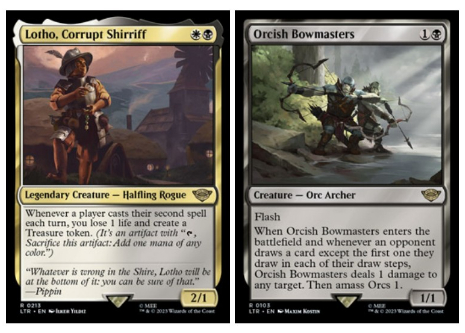
The Ring Tempts You ensures you max the ring benefits quickly and draws cards everytime you name a ring bearer, again, for life you can generally afford to lose. Lotho, Corrupt Sherriff is a great commander in its own right, and does solid work here generating treasure tokens at largely irrelevant cost of life. Likewise, Orchish Bowmasters is a great new black EDH staple that does the same kind of work here as Lotho, namely via punishing opponents who are trying to do too much by pinging any target and providing creature tokens that can end up doubled if you don’t already have one. Rapacious Guest adds additional synergies between food and the attack step.
The Great Henge isn’t at it’s best here, but as The Party Tree box topper, it still is likely to cost 4 mana or so in the mid-game and provide card advantage, mana ramp and consistent life gain. Shadowspear helps ensure you have consistent access to lifegain and trample for your ring bearer, with the side benefit of letting you remove hexproof and indestructible from opposing threats, and can be searched up with Urza’s Saga. Revive the Shire gives you a regrowth effect that also incidentally makes a food. Delighted Halfing provides an additional Cavern of Souls style protection from counterspells on key legendary spells, of which this deck has plenty. Gilded Goose doubles as mana and food production, so it’s a no-brainer. Trail of Crumbs ties everything together, both generating food and allowing you to turn food into cards.
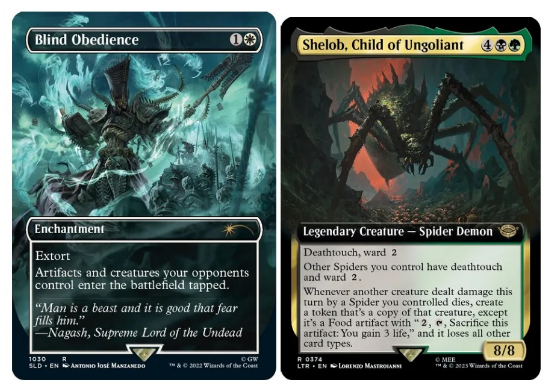
Blind Obedience slows your opponents down while letting you leverage spells cast into additional table drain. Shelob, Child of Ungoliant might be a hot new spider commander but she also does solid work in this deck as a massive threat with built in protection and the ability to significantly upgrade dead utility creatures from your opponents into food with upside. Denethor, Ruling Steward provides additional table drain, and his creature replacement ability interacts really well with your token doublers. Sheoldred, the Apocalypse bleeds your opponents for card draw while boosting your life gain and providing a solid ring bearer.
War of the Last Alliance searches up two key legends out of your deck and then sets up a big attack phase while tempting your ring bearer. Of Herbs and Stewed Rabbit grows a creature, draws a card and makes two food, capping off with a big creature token payoff. Dauthi Voidwalker does its usual thing here, keeping opposing yards in check while also presenting a nasty ring bearer. Angelic Accord rewards your constant life gain with 4/4 angel threats that can present an alternate win condition. Inkshield goes a step further, heading off a potential killing blow from an opponent and likely unleashing a devastating torrent of tokens from your token doubler effects. Kambal, Consul of Allocation provides additional incidental drain and Esper Sentinel draws cards for minimal cost as per usual and Smothering Tithe does the same for treasures that might get doubled. Necropotence cleanly draws a ton of cards given your life gain potential.
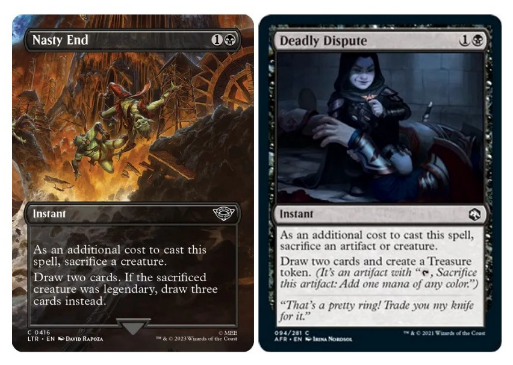
Nasty End and Deadly Dispute both allow you to trade up easily on cards in a deck with so many cheap Legends and artifacts. I’ve been trimming tutors from my decks lately, but clearly Worldy Tutor, Vampiric Tutor, Eladamri’s Call, Demonic Tutor and so forth can all boost your consistency in high powered pods.
Key Lands
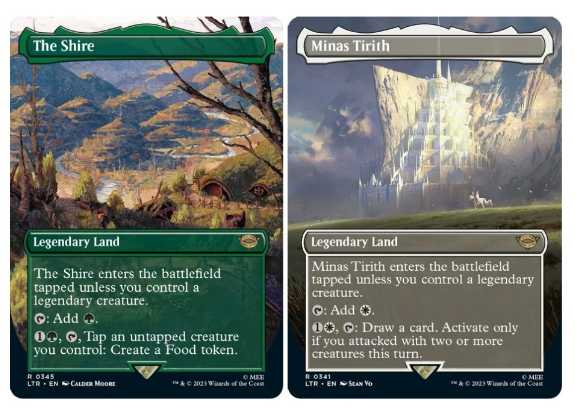
The Shire offers additional food production which is perfect here. Minas Tirith provides optional card draw during your frequent attacks and rarely comes into play tapped.
Because you’re gaining so much life, you can absolutely lean into the pain lands in this deck and run Mana Confluence, City of Brass, Horizon Canopy, Ancient Tomb, Brushland, Caves of Koilos and Silent Clearing.
Yavimaya, Cradle of Growth and Urborg, Tomb of Yawgmoth auto fix for two of your main colors. If you’ve got them, the full suite of fetch lands and shock lands are a lock. Add as many of the CMR/CLB duals as you have on color. Urza’s Saga can get half of the Cat Oven combo or Shadowspear, Sol Ring or Mana Crypt. If you’ve got a Gaea’s Cradle it will do work here. With so many powerful enchantments in the deck, Hall of Heliod’s Generosity is likely to do work. Volrath’s Stronghold does the same for your key Legends.
The Specs
Now from an MTGFinance perspective, speculators and players should likely focus on cards with lower supply, less printings and a high chance of being added to variants on this build.
A couple of key options include:
– Academy Manufactor FEAs, $16 and climbing with plenty of existing EDH demand being expanded upon with the advent of this food deck
– Boon Reflection, last seen in Double Masters and available near $5 in both foil and non-foil though it could see a reprint in a Secret Lair or Commander Masters this year
– Rhox Faithmender foils, single printing from 2013, currently near $10 but headed to $20+ if it doesn’t catch a reprint
– Feasting Troll King is a solid threat in this deck if your mana base can support it, and FEAs are single printing, low supply and sitting at about $10.
– Angelic Accord hasn’t caught a reprint since IMA, and foils are sitting hear $6 with very low supply
– This deck generates pressure for Parallel Lives, Anointed Procession and Doubling Season, but that pressure base is already large, and at least some of those have to catch a reprint in Commander Masters.
Here again is a link to my upgraded version of The Hobbit’s Banquet, all ready to serve as a jumping off point for your own culinary delights. Bon appetit!
James Chillcott is the owner of MTGPrice.com, Senior Partner at Advoca, a designer, adventurer, toy art fanatic and an avid Magic player and collector since 1994. He has been producing MTGFinance content since 2012.
